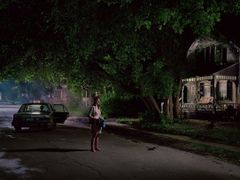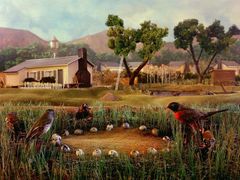Review - Imagine the outwardly orderly characters of the Desperate Wives TV show struck by paranormal phenomena. Imagine the suburb dwellers with half of their brains destroyed by the mysticism of The X Files and real Martians returned to the comfortable burgeois idyllic scene.
These are the characters U.S. photographer Gregory Crewdson crowds his gigantic photographs with. It is a world close to nervous breakdown and complete madness.
The catastrophe has already taken place but those struck by it have not yet realized the consequences.
Director rather than photographer
Crewdson situates most of his photos right in the cinematic endless second before the shock realization when everything gets quiet just to break down.
And speaking of obedience to the cinematographic effect, we have to add that the photographer's visit card should read "Director" rather than "Photographer".
Starting with the Twilight series dating back to the end of the 90's and featuring his suburban obsession register at its full scale, Crewdson is no longer the guy squeezing his large format camera button, either.
In psychiatric office
A standard film crew of up to 150 participates in the careful arrangement of the photographs leaving nothing to chance. All the lighting is taken care for by electricians, a shot frequently takes up to two weeks and costs may reach to even a million dollars.
We can say with some exaggeration that Crewdson revived his one-shot and one-take blockbusters with the psychoses he learned about as a boy from his father's patients.
His father used to have a psychiatric office in Brooklyn with the small Gregory's room right above it. Crewdson, with his ear on the floor, tried not to miss the least thing from the subconscious of his father's clients.
The hyper-realistic blow-ups that are perfectly sharp all over the picture due to digital fixation harmonize with the nightmarish world of the orderly and super clean residency quarter whose facades, neat gardens and opened bathroom boxes hide psychopharmacs, domestic violence and self-damaging.
The belongings of the dim characters with empty faces crawling through Crewdson's interiors and streets often speak for them: parked cars with the headlamps turned on, the always opened dressing cases, open boxes with cleaners, served food and neatly cleaned households.
Pervesion in suburban conformity
Crewdson in fact only used the longwinded American tradition which finds the sources of various perversions in the suburban conformity.
Starting with The Stepford Wives by Ira Levin through to Lynch's Blue Velvet, Burton's Edward Scissorhands, American Beauty and the above mentioned Desperate Wives.
In addition, Crewdson fed all of this with the pre-millennium uncertainty of the 90's and easily decipherable psychologisms, e.g. the continually repeated toilet bowl leading from the neat, cultivated space into the chaos of the subconscious.
Also the inconspicuously expanding nature getting ready to get hold of the helpless residents is all-present. Grass intergrows into rooms, a sparrow made her nest on the dressing case.
The only objection may concern the fact that the amount of exhibited photos gradually reveals that Crewdson again and again repeats one and the same phobia.
This is slightly pulverizing and its grooviness shows especially in the slightly formal set with Hollywood actors called Dream House and ordered by The New York Times.
However, in general it does not diminish his Hitchcockian mastery to find horror where it could be expected but in quite a different form.
Gregory Crewdson. Rudolfinum Gallery, Praha 1, nám. Jana Palacha. The exhibition lasts through 25 May 2008.











